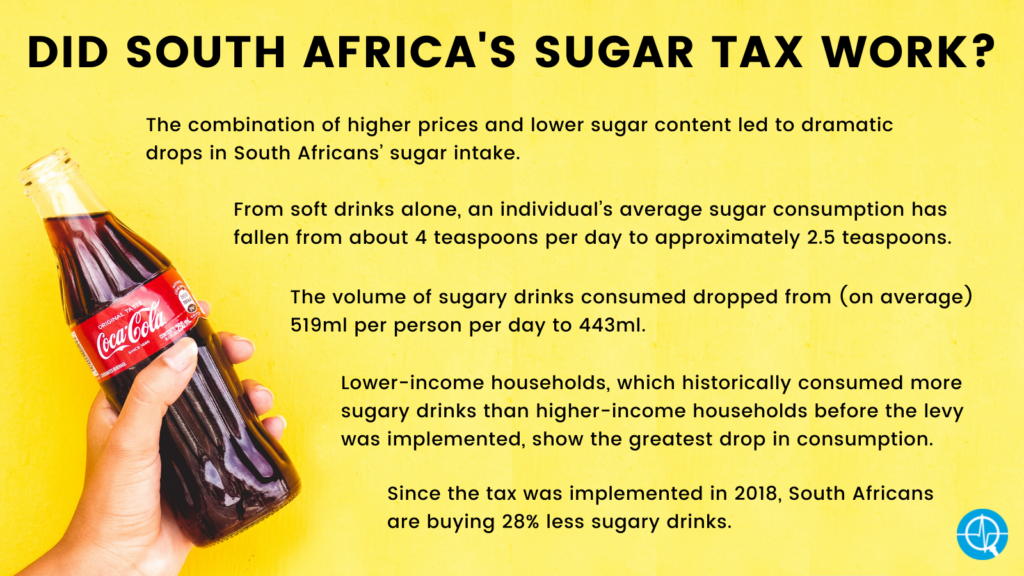- The evidence is in – South Africa’s sugar tax is working. People are buying 28% fewer sugary drinks since the government implemented the health promotion levy in 2018.
- Under this policy, sugar manufacturers are charged a fee of 2.1 cents per gram of sugar per 100 ml.
- This pushed producers to cut the sugar in their soft drinks to avoid the tax, and to push up the price increases onto consumers by hiking retail prices. The combination of the two has cut sugar intake in the country by nearly a third.
When it comes to good health, sugary drinks are bad news. Scientists working in this field agree that regularly consuming sugar-sweetened beverages – such as fizzy sodas, juice drinks with added sugar and energy drinks – is a major driver of obesity and chronic, non-communicable diseases such as type 2 diabetes.
Type 2 diabetes, which is more common among adults, is an impairment in the way the body regulates and uses sugar and results in too much sugar circulating in your bloodstream. This can lead to disorders of the circulatory, nervous and immune systems.
One way to get people to drink fewer sugary drinks is for governments to implement sugar taxes. South Africa implemented a sugar tax in 2018 by charging the manufacturers of sugary drinks a levy on the sale of their products.
In May this year, the first scientific evaluation of South Africa’s “sugar tax” was published. And, say the authors, it is paying off: South Africans are buying 28% less sugary drinks, and have consequently markedly reduced their sugar and calorie intake.
The Health Promotion Levy, the tax on sugary drinks implemented in 2018, was an attempt by the South African government to address the country’s raging diabetes epidemic and the high rates of obesity that fuel it.
With more than a quarter of South Africans living with obesity, we are among the top 20% of the most obese nations in the world. Add to that that about one in eight South African adults – more than 4.5-million people – are diabetic, and we know we are in trouble. In fact, in 2018, diabetes was the second-largest cause of death among South Africans after tuberculosis.
Craving Coke: How South Africans are hooked on sugar
South African consumers admit that we have a problem.
From a 2019 study published in the journal Public Health Nutrition that looked at Soweto residents’ attitudes to sugary drinks and their taxation, people seem to crave a sugar fix:
“Every day, before I sleep, after eating, I need to have a Coke,” said a young adult woman.
“Amongst like my friends’ families, most of their parents, brothers, sisters, they [sic] addicted to it, like they’ve been drinking it since like your early-age years and some of them are like in their fifties,” said another young man.
“Eish, if I don’t get it here, it’s like there is something missing. It’s addictive, you … need it every day,” said an older man.
In the 10 years between 2002 and 2012, South Africans’ consumption of sugary drinks surged from 183 Coca-Cola products per person per year to 260. To put this in perspective: it works out to two drinks every three days instead of two drinks every four days as before.
Science shows that drinking even one sugary soda a day increases an adult’s likelihood of being overweight by 27%, and a child’s by 55%. South African 9- and 10-year-olds drink an average of 254 Coca-Cola products per year (compared with the global average of 89). This statistic makes them the second-highest consumers of sugary drinks in the world, says Karen Hofman, a leading investigator of South Africa’s sugar tax and one of the authors of the recent evaluation.

Obesity-related chronic diseases such as type two diabetes are a public health concern. Apart from the tragic human costs of diabetes, the disease also puts an increasing burden on our public health system. Almost a third of all cases go undiagnosed and untreated, and a recent study estimated that in 2018 just the direct medical costs for type 2 diabetes were roughly R2.7-billion for diagnosed patients. When undiagnosed patients were included, this cost estimate surged to R21.8-billion, which represents 12% of the entire national health budget for that year.
The same study estimates that by 2030 the disease will cost the public health system R35.1-billion, about equally split between management of the disease itself and complications such as kidney failure, stroke, blindness and amputations.
These estimates do not take into account the additional, indirect economic costs, such as loss of income, unemployment, loss of productivity and disability, the social costs related to any of these consequences, or the downward spiral of poor nutrition as a consequence of poverty.
The cost of sugar: How the health promotion levy works
Sugary drinks account for one-third of all sugar consumed by South Africans. Liquid sugar calories are especially harmful, which partly explains why the country’s levy specifically targets sugar-sweetened beverages and not all beverages containing naturally occurring sugars (such as milk or 100% fruit juices) or foods with a high sugar content.
The tax is a “duty at source” – in other words, paid by the producer – and calculated according to sugar content rather than the item’s total volume. Producers pay 2.1c per gram of sugar per 100ml, after a “free pass” for the first 4g per 100ml.

This structure incentivised producers to do two things: first, they passed the price hike on to the consumer in the form of higher retail prices. Second, manufacturers reduced the sugar levels in their drinks, so as to reduce their tax liability, in many cases replacing sugar with “non-nutritive sweeteners”.
Non-nutritive sweeteners are food additives that taste sweet, but add no or almost no energy to a food. They are therefore used as low- or no-calorie alternatives to so-called “nutritive” sweeteners such as sugar and high-fructose corn syrup.
Hofman and her team’s recent evaluation shows that the combination of higher prices and lower sugar content has had a positive impact, and the study links the Health Promotion Levy directly to dramatic drops in South Africans’ sugar intake.

From soft drinks alone, an individual’s average sugar consumption has fallen from about four teaspoons per day (16.25g) to approximately 2.5 teaspoons (10.63g). This reduction is substantial, given that the World Health Organisation (WHO) recommends we aim to limit our daily intake of added sugar to a maximum of 12 teaspoons a day, but preferably closer to only six for best results.
The volume of sugary drinks consumed dropped from (on average) 519ml per person per day to 443ml. Lower-income households, which historically consumed more sugary drinks than higher-income households before the levy was implemented, show the greatest drop in consumption. The study observed no change in people’s consumption of non-taxed beverages, such as 100% fruit juices.
A roadmap for South African health: How the “sugar tax” fared in other countries
The effect of the sugar tax is a much better early result than some projected, as its structure was criticised for being compromised from the start. At the final rate of 11% of the price of one litre of a sugar-sweetened beverage, it was considered not high enough and seen as the result of government’s bowing to pressure from the sugar industry: a year-long “public consultation” period resulted in the proposed tax being reduced from 20% to 10% (effectively 11% by the time it came into effect, due to an inflation-linked rise).
But it’s too soon, Hofman says, to prove with local research that taxing sugary drinks (and potentially all sugary and ultra-processed foods) leads to fewer cases of obesity and diabetes.
“The issue of the long-term impact on diabetes and obesity is harder to show because it takes many years to show that. In Finland, where there’s a lot of health promotion, it took 20 years before the health of Finnish citizens really changed in terms of life expectancy from non-communicable diseases. But we have to start somewhere. This is not a silver bullet, but it is one of several things that must and should be done. The fact is, taxes have worked across the world, many jurisdictions have had success and are showing that these taxes actually do work.”
Rates of obesity and diabetes are rising globally, and more than 50 countries, including Botswana, Zambia and Morocco, have introduced a tax on sugary drinks. Although countries such as South Africa, Mexico and Chile chose to implement a tax rate below the minimum of 20% recommended by the WHO, they still seem effective at reducing consumption of sugary drinks.
Mexico, for example, introduced a levy of one peso per litre of a sugar-sweetened beverage in 2014 and saw purchases of sugary drinks drop by an average of 7.6% in the first two years after implementation (a reduction of 5.5% in 2014 and 9.7% in 2015). According to an analysis published in Lancet Planetary Health, the impact of South Africa’s tax is even greater, and has prompted the authors of the study to suggest “a potential role for sugar-based taxes more broadly”.
Deadly bedfellows: COVID-19, obesity and diabetes
The world over, COVID-19 has highlighted rafts of neglected or under-emphasised health conditions – as well as horrifying inequities in health systems – and obesity stands out as a big one in this particular pandemic.
The evidence is clear, experts say, that overweight and obesity is a major risk factor for worse COVID-19 outcomes. An analysis of data from close to 400 000 patients with COVID-19, published in Obesity Reviews in August last year, showed that people with obesity had significantly higher chances of needing to be hospitalised, being admitted to an intensive care unit or dying, than people of healthy weight.
Hofman confirms that this applies in South Africa, too, noting that many hospitalisations and deaths from COVID-19 have been people with underlying and obesity-related conditions. And, she says, “efforts to try and address this obesity-related tsunami have not been taken into account by the government”.
WHO director-general, Tedros Adhanom Ghebreyesus, called an earlier report by the World Obesity Forum that also highlighted the link between obesity and poor COVID-19 outcomes “a wake-up call to governments globally” to take their obesity problems in hand.
“The government is very focused on COVID,” Hofman says, “but for some reason they have not focused as much on an equally devastating tsunami — diabetes — and the costs from blindness, kidney failure and strokes are often not taken into account. There’s the cost of hospitalisation for COVID, the [personal] cost for families and individuals of losing their loved ones – but much of it could have been prevented, and that does not seem to have factored into their [thinking].”
Sweet nothings: South Africa’s stalled fight against sugar
In 2013, the former health minister, Aaron Motsoaledi, spearheaded the Strategic Plan for Prevention and Control of Non-Communicable Diseases (2013–2017) and, in 2015, the National Strategy for Prevention and Control of Obesity. The plan ambitiously targeted a 10% reduction in obesity levels by 2020, yet there has been no reporting by government on progress towards this target since, nor updated versions of the strategies.
Bhekisisa’s attempts over several weeks to get a response from Lynn Moeng, the chief director for nutrition at the health department, have so far been unsuccessful.
The link between consumption of sugary drinks and weight gain is incontrovertible. In 2017, Hofman praised the government for its “far-sighted” initiative to introduce the tax, joining many others in saying “it’s a start” although cautioning that it was “the first step in a very long journey of a range of different interventions that will need to happen”.
The favourable impact of a sugar tax on reducing consumption of sugary drinks has now been proven in South Africa. The next step, Hofman says, would be for the government to raise South Africa’s sugar tax from 11% to the WHO-recommended 20%, to mandate front-of-package labelling (for all foods) and ban the marketing of unhealthy foods to children, methods which international experts on sugar and food policy argue are necessary to address obesity.
No increase in the country’s sugar tax was announced in the annual budget speech by the minister of finance in either 2020 or 2021. And, Hofman says, according to her sources, it seems that at this stage the government doesn’t intend to raise the Health Promotions Levy before 2022, after having reached an agreement with the sugar industry.
The health department had not responded to a request for comment by the time of publication.
Adèle Sulcas writes about global health and food systems, and worked previously at the Global Fund to Fight AIDS, TB and Malaria, and the World Health Organization. She is former editor of the Global Fund Observer.





